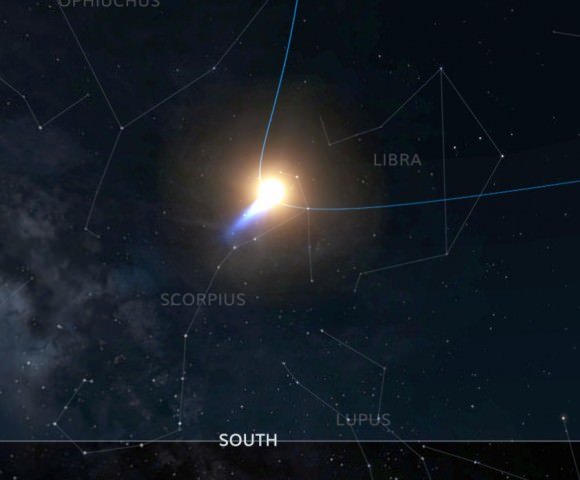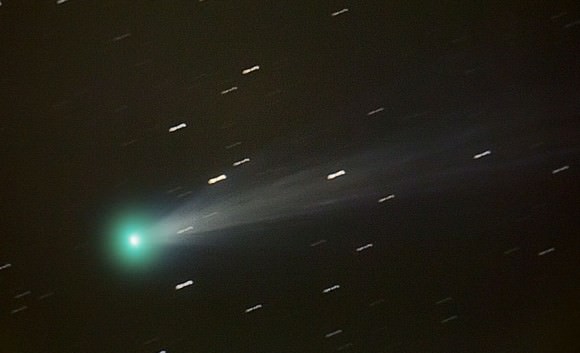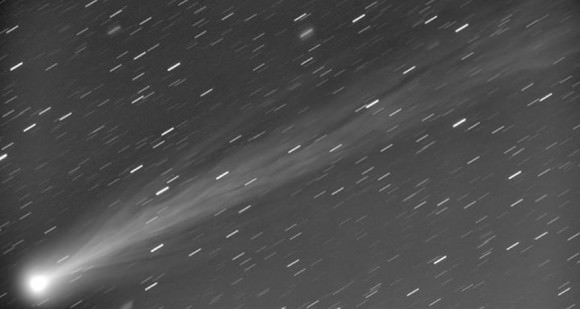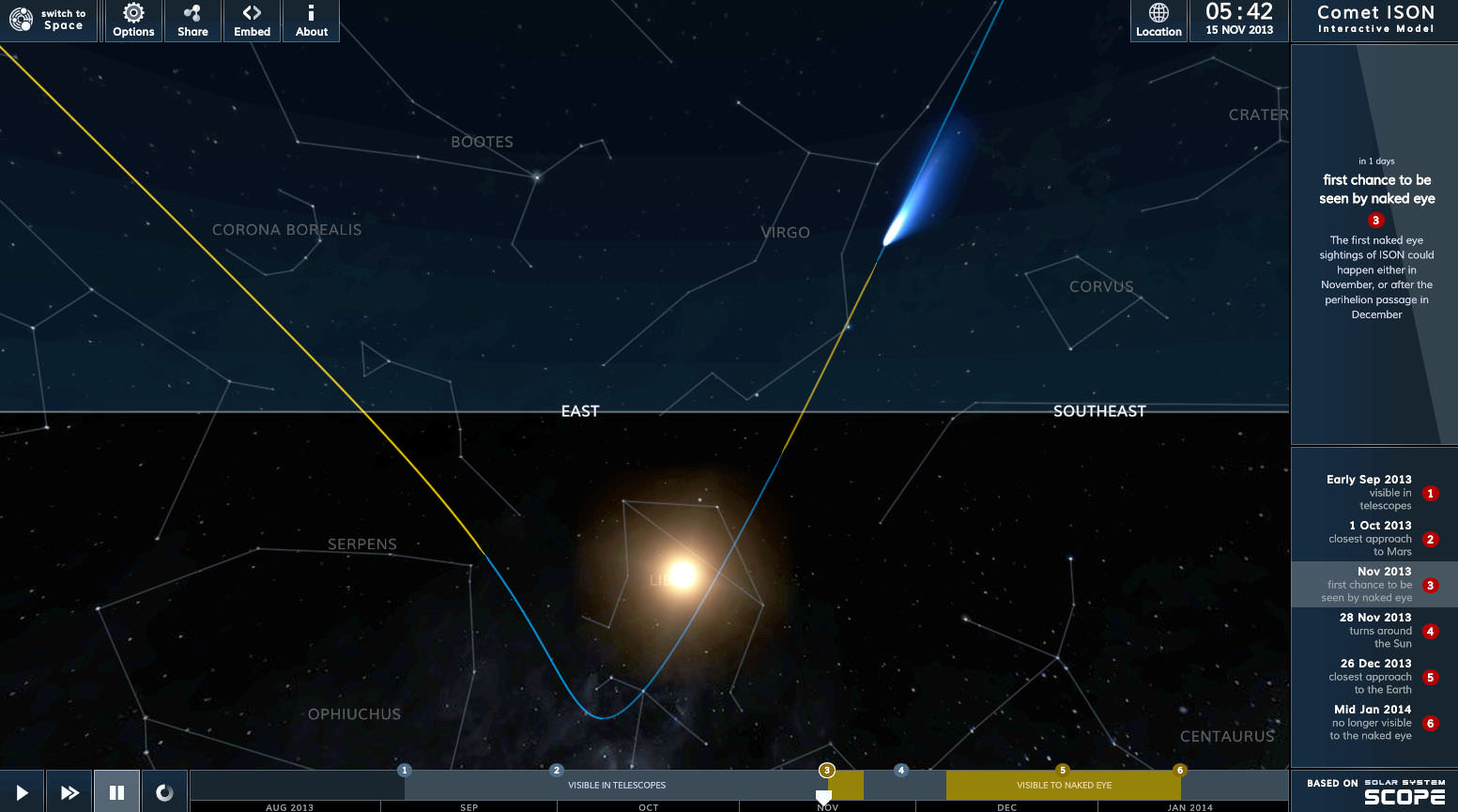Here’s a handy tool. The folks at INOVE Space Models have just updated their awesome Comet ISON flyby simulation with a second point of view – how it looks from Earth. The first version let us watch from afar as ISON dives across across the solar system until it makes a hard left at the sun and returns to deep space. The new view lets you watch it track across the sky across from any location on Earth. Go to the link and toggle the Switch to Earth option in the upper left of the display and you’re off. The website attempts to automatically pinpoint where you are, but for me it was a tad off, selecting a town about 75 miles away. But a few miles this way or that make little difference given how far the comet is from Earth. If you need to make an adjustment, click the Location icon (upper right) and select your latitude and longitude.

You have two options for viewing. If you click the single arrow play button at the bottom of the screen, the display shows a horizon line with the stars, sun and comet rising and setting over a single day. In a day’s time the comet moves only a small distance in the sky, so it will appear in nearly the same spot the next day. Except around perihelion on Nov. 28. Then it moves so quickly – over 800,000 mph (1.3 million km) – fast enough to watch move hour by hour.
Besides just being plain cool to watch, the simulator is truly useful. The background star field shows constellation outlines and stars down to about 5th magnitude. Assuming the comet is reasonably bright, say 5th magnitude or brighter, you can use the simulations as locator maps now through the end of January. By clicking on the Time Box at upper right, you can set it to any time you like, grab a frame and head outside for a look.

Pressing the double arrow fast-forward button shows changes in position one day after another. To know what day you’re on just consult the timeline at the bottom of your screen. You can manually pull the time arrow to speed up, slow down or select a particular time of month. Other refinements are available in the Options box at upper left. Should you tire with Comet ISON from an earthly perspective, just click on Switch to Space at upper left and you’ll zoom back out for a solar system perspective. Enjoy the journey!

The un-simulated Comet ISON underwent a powerful outburst on Nov. 14 brightening by two magnitudes, as the two images here from Leonid Elenin and Scott MacNeil attest (and you can see more in our article from yesterday)
What had been a faint object in binoculars has become much more impressive. I caught it in my 10x50s in some small cracks between the clouds this morning (Nov. 15) and estimated its magnitude at 5.0. Had it been clear, I would have seen it with the naked eye. Through a 15-inch (37 cm) telescope at 64x the coma, now twice its pre-outburst diameter, glowed more blue than green with a dense core that looked like a bright, fuzzy star. Frankly, ISON was beautiful. Let’s hope this little outburst leads to better things to come and not early signs of the comet’s dissolution. Take a look yourself at the next opportunity and there might be a surprise waiting for you.


Tried looking for it this morning from Kenai Alaska. Located Spica and stared all around it and saw nothing. Of course I only had a crappy pair of binoculars but still I thought I’d see something. Hugely disappointed. I’ll try again tomorrow.
Seems rather ambitious to see ISON with naked eye or binoculars. Getting too close to the dawn light. Comet is also somewhat small. Hopefully, December will prove to be a much better viewing window. Now about that close swing around the Sun come 11/28….
saw it 4 the 1st time this AM in binos! Not as clear as Lovejoy, which was more distinct in binos, also seen for the 1st time in binos, thus doubling in a few hours the # of comets i know i’ve seen in my life!
I notice that the ISON’s orbit appears to shift over time, the sun is not centered relative to the orbit as it is at perihelion. I think it’s because of changes in the Earth’s position in its orbit and gradual shifting of its axis? I’m not sure myself.
ur comment is very confusing. do u mean the shifting of earth on its axis? are u trying to say the orbit isn’t symmetrical as u expected?
Sorry about the confusion. What I’m trying to say is, the ISON is following a parabolic orbit(or an extremely elliptical orbit) with the Sun located at one of the focal points, right? So I was expecting that, from the point of view of a person standing on the Earth’s surface looking up, that Sun’s position in relation to ISON’s orbit would remain fixed at all times.
But in the simulator, the ISON orbit and the Sun drift apart, the Sun doesn’t seem to stay right at the orbit’s focal point at all time. This is more apparent when you move the time control forward and backward to accelerate the time. That was contrary to my expectations and confused me.
I was wondering if there are other factors involved, such as the Earth’s axis position with respect to its orbit changing as the Earth moves around the orbit(the same change responsible for giving us the seasons)
I hope this makes more sense now…
it does now. still complex tho. the space view looks perfectly parabolic. i would guess that this might have to do with the fact that the earth is moving in orbit from day to day so the perspective on the parabola keeps changing so it looks different. (just as the sun, while stable at the center of the solar system, appears to shift “thru” constellations. (yes i know it is still moving thru space but that is irrelevant here.)
Hey Bob this is great since now i know what part of the sky nearby the sun to look at if i wanna try to see if ISON is visible at perihelion! and it’s great 4 us in N America as ISON goes from being W of the sun at sunrise to E of the sun at sunset! hoping 4 clear skies. also, hoping ISON will get bright enough to see.
When and where should I be looking in the rhode island sky to see this spectacular view?